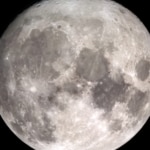Five things you didn't know about human beings’ arrival on the Moon
"One small step for man, one giant leap for mankind" was Neil Armstrong's famous phrase when he first stepped on the surface of the Moon. The phrase served to crown one of the greatest feats carried out by the human species whose 50th anniversary is celebrated this year.

Despite how it might seem, the mission was far from an easy task: the complicated historical context, the high economic cost or the little technology they had at that time might well have jeopardized the operation. However, the three astronauts who took off from Earth aboard the Saturn V ship returned to our planet safe and sound.
To celebrate the half-century of the Apollo 11 mission, we will tell you some of the lesser-known details of the journey that kept the entire world population on tenterhooks.
Astronomical figures for a stellar feat
In keeping with its historical weight, the mission left great figures that also passed into history. The Apollo program was assisted by nearly 400,000 people who worked directly or indirectly to bring Armstrong, Aldrin and Collins to the Moon with a budget of $25 billion at the time (about $153 billion if we adjust for current inflation).
Neil Armstrong's first steps on the satellite were watched live on television by 600 million people worldwide, which is to say almost 20% of the world's population at the time.
In all, Apollo 11's mission lasted just over 8 days from take-off to return to Earth. Of those 195 hours, Armstrong and Aldrin spent only two walking on the lunar surface. During that time, they deployed the American flag and placed a commemorative plaque, spoke with President Nixon by telephone, conducted various experiments, installed a seismograph and laser reflectors that would allow data from the satellite to be collected from Earth and collected a total of 22 kilos of lunar rocks for analysis.
Spain: a privileged place
Although the Apollo program was created, developed and funded by NASA, many participated from other corners of the planet. The United States established three monitoring stations for the Apollo program: one in California, one in southwest Australia and one in Fresnedilla de la Oliva, 50 kilometers from Madrid, with the aim of covering communication with the Moon over 24 hours.
At the time of the Apollo 11 moon landing, the location of the peninsula was facing the Moon, so the location of the Fresnedillas station was in a privileged position. From there, communications from the lunar module were received and, therefore, they were the first to hear Armstrong's words, with a few seconds’ difference from NASA's operations center.
José Manuel Grandela, a Spanish engineer who was then working at the station, was there and later participated in the BBVA OpenMind event Objective: the Moon, where he recounted his experience. "We had the honor of being the natural, unique and exclusive controllers between the Earth and them. As soon as we heard the words Houston, Tranquility Base here, the Eagle has landed, that was a moment when we all exploded. Without realizing we had been holding our breath and we had the strength to embrace each other because the first phase of the mission had been achieved".
The women of the space race: relegated but fundamental
During the space race of the 60s, not a single woman was considered to travel to space in the Apollo program. The first American woman to do so was Sally Ride and she did not do so until 1983. However, many women worked from Earth on space missions and, although initially they were intended to perform secondary operations, review computer calculations and write minor code, their role was crucial to the success of the program.
Two of the most important were Katherine Johnson and Margaret Hamilton. Johnson, an African-American mathematician and physicist, had to face the prejudices that were held in the time about her sex and race and made the trajectory calculations of Apollo 11 on its trip to the satellite. The accuracy of her calculations ensured that the lunar module could land on the Moon's surface. Her work also helped the Apollo 13 astronauts returning to Earth after the explosion of an oxygen tank in the ship.
Hamilton, a computational scientist, was in charge of developing the navigation software of the lunar module. Three minutes before the moon landing, the alarms tripped due to the activation of an incorrect protocol, which was about to cause the mission to fail, but thanks to the task prioritization system developed by Hamilton, the Eagle was able to land.
A complicated journey
Being the first human to step on the Moon is an honor that will always belong to Neil Armstrong, but his legacy goes further. His feat inspired later generations and thousands of children grew up with the dream of traveling to space. As of today, some 560 people in total have managed to do so in one way or another, but today's conditions are not those of the sixties.

In addition to Armstrong and Aldrin, ten other men have set foot on the Moon as part of the Apollo program.
The three crew members of Apollo 11 were experienced pilots, had a vast knowledge of Apollo systems and were participants in the Gemini program, the predecessor of Apollo, in which they had successfully completed missions. Since the crew announced that it would carry out the mission, the three had six months to prepare by completing a hard training regime that subjected them to the most extreme conditions and that included piloting and moon landing simulations.
The trip was not much more pleasant: the spaces inside the ship were very small, the position was very uncomfortable, the food was tasteless and the mission had complicated moments in which the worst was feared. Even President Nixon had a speech prepared in the event that the three astronauts did not return to our planet safe and sound. However, upon returning to Earth, the astronauts had to spend 21 days isolated in quarantine because of the possibility that they could have brought some pathogen germs with them.
2024: Back to the Moon?
In addition to Armstrong and Aldrin, ten other men have walked on the Moon as part of the Apollo program. Twelve people in total in six different Apollo missions. The last to do so were the crew members of Apollo 17, Cernan and Schmitt, in 1972, 47 years ago. The question is, will a human walk on the Moon again? For what purpose?
The Trump administration has already unveiled its intentions to provide its space agency with sufficient resources to launch the Artemisa program, aimed at returning to the satellite in 2024. Vice President Pence claimed this year that "NASA is ready for the challenge of moving forward to the Moon, this time to stay." In addition, this program plans to take the first woman.
But not only NASA intends to return. The space agencies of Russia, China and India have also launched plans to "reconquer" the Moon. For its part, the European Space Agency (ESA) has shown interest in developing a permanent lunar base.